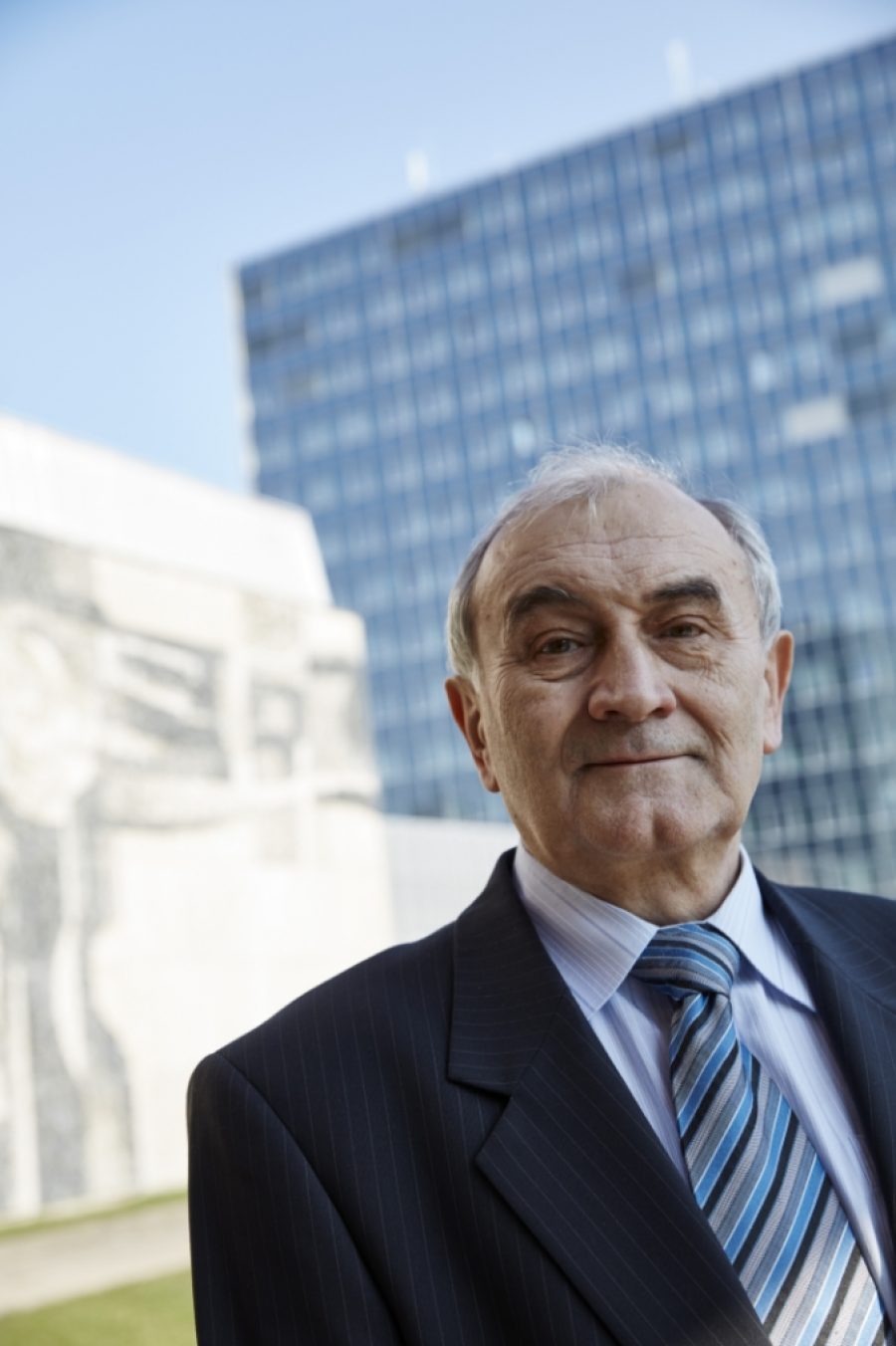MIROSLAV SEDLÁČEK
Miroslav Sedláček (*1950) invented and developed a bladeless hydropower turbine, which can shift electricity production to creeks with an extremely low gradient and flow. It can also be used in sea tide and outflow. All these “waters” sources remain unused. The turbine is protected by patents not only in Europe but also on other continents.

Miroslav Sedláček in front of the Faculty of Civil Engineering, CTU in Prague, where he lectures; Photo Archive of Miroslav Sedláček
A most important achievement
A small model of bladeless turbines exists in every household. When bathing water is drained from the tub, pull the plug on the chain just a few millimeters above the drain hole. After a moment the water starts to run out, the stopper begins to rotate around the inner edge of the sinkhole, and the chain spins in your fingers. Sedláček’s turbine works on a similar principle, however, instead of the stopper, the hemispherical body (rotor) rotates in the drain hole. The rotor shaft can be suspended at the top or supported at the bottom of the turbine. It is always allowed to move a few degrees from the center of the axis in all directions. The passing liquids cause the rotor to roll on the inside wall of the outlet cone. The rotor is firmly attached to the shaft and generator. The generator produces electricity. It is also possible to reverse its
funcion by driving the rotor and use it’s principle as water pump or other useful equipment using a gear or a belt. The team of inventors, in collaboration with CTU in Prague, Institute of Thermomechanics of the Czech Academy of Sciences and the company called MECHANICS and PROTUR has gradually verified various microturbine design variants. The turbine derives its name from the name of the main inventor “SETUR” (SEdláček’s TURbine). Several versions of the hydromotor have been developed for gradients (heads) ranging from 0,6 m to 20 m and flow rates from 4 to 200 l/sec. The measurement showed 50 to 60 % efficiency. The smallest type of microturbine can reach up to 2 kWh per day depending on the gradient and flow, the most powerful has a capacity cca 50 kWh per day.


Biography
Having obtained his engineering degree at the University of Economics, Prague in 1976, Miroslav Sedlacek then worked as a university lecturer in economic subjects. In the recent years, he has focused on microeconomic research and sustainable development. In 1986 he obtained his PhD candidate and in 2016 a Assoc. Professor degree in Management and Economics in Construction. He has been working at the CTU in Prague Faculty of Civil Engineering since 1994.
S
Benefit for society
The turbine can produce electricity on water streams with a small gradient and water flow, or also from a very low sea inflow and outflow. At such places, the current water turbines cannot work with economic efficiency. Therefore, the greatest benefit of Sedláček’s invention is the use of these watercourses which, according to experts, contain about a half of all water energy on Earth. It is particularly suitable for hamlets and remote locations, where it is not feasible
to invest in cable connections or grid connections. The turbine can also power pumps for local irrigation systems. If required, both functions, generator and pump drive can be technically provided. The device can therefore significantly improve the lives of people whose homes cannot be connected to electric grid for technical or economic reasons. Similarly, the turbine can contribute to higher food production by irrigating land.

Awards
The bladeless hydropower turbine brought its inventor first place in the competition for the most economical technology and the prestigious prize NEGAWATT at the international conference in Prague in 2002. In 2003 it was awarded the Golden product in the field of power engineering at the Electrical Engineering Fair in the city of Ostrava, Czech Republic, first place in the competition for innovation in 2006, third place at the 6th exhibition of inventions in Suzhou, China, in 2008, bronze and gold medal from the International Fair IENA in 2008 and 2010 and also the gold medal from the International exhibition of inventions in Budapest in 2009. He obtained Gold medal from the World Intellectual Property Office in Geneva for a patent solution and another gold medal from INVENTO Prague 2014, from the International exhibition of Inventions IWIS in Warsaw, in 2014. In the same year the inventor got the Ecologic Oscar, E.ON Energy Globe Award and the bronze medal from the International exhibition KUNSHAN in Jiangsu, China. In 2016, he was nominated among the three best inventions in Europe in the research category.
Trivia
The idea for a turbine without blades exploiting the vortex principle came to Miroslav Sedláček during a walk along the river. He was watching the whirpools on the surface and noticed that the fallen leaves at their edges sometimes rotate around their axis opposite to where the rotation of the whole water vortex is directed.

